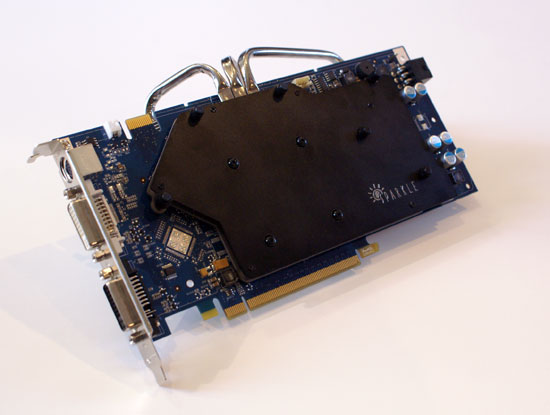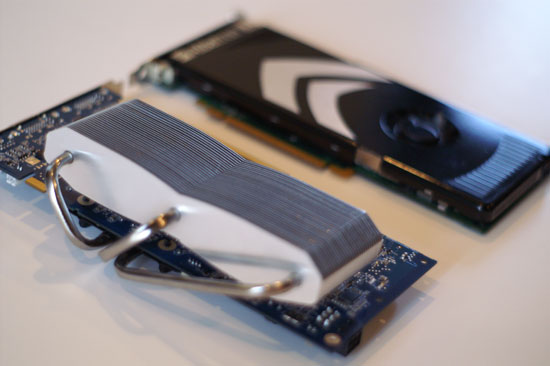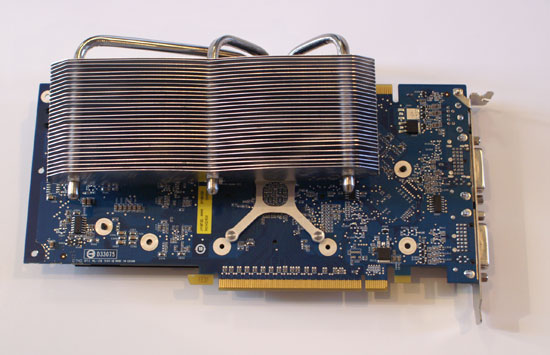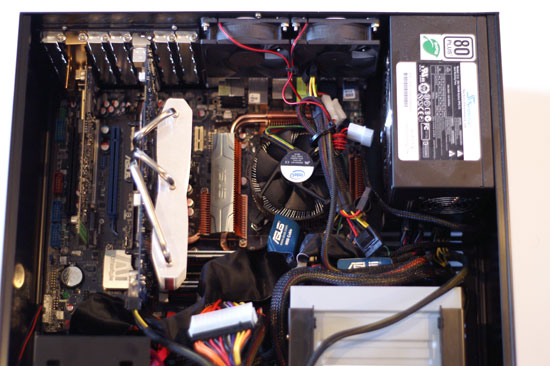
Original Link: https://www.anandtech.com/show/2389
Sparkle 8800 GT Passive: The Fastest Silent GPU in the World
by Anand Lal Shimpi on November 29, 2007 12:00 AM EST- Posted in
- GPUs
So about that pricing...
NVIDIA's GeForce 8800 GT launched to much praise from us, you all and other reviewers altogether. We've got a roundup of 8800 GTs in the works and today we're looking at a very special 8800 GT that those building silent PCs may be interested in. But, before we go much further must address the current situation with 8800 GT pricing and availability. There are a couple of givens:
1) GeForce 8800 GT availability is extremely limited, and
2) Pricing is much higher than expected
NVIDIA’s original target for the 8800 GT was $199 for the 256MB version and $249 - $259 for the 512MB version, and while 256MB cards are just now starting to appear in the worldwide market, 512MB cards just can’t be bought at those prices.
A quick look at Newegg shows that most cards are priced between $270 and $320, but almost all cards are out of stock at this time. If you're willing to spend a little more you can find cards selling for $330 - $350, but then you run into some very creative pricing on shipping.
Our own Gary Key took screen shots of his checkout cart at three different stores, pay attention to the rates for overnight shipping:
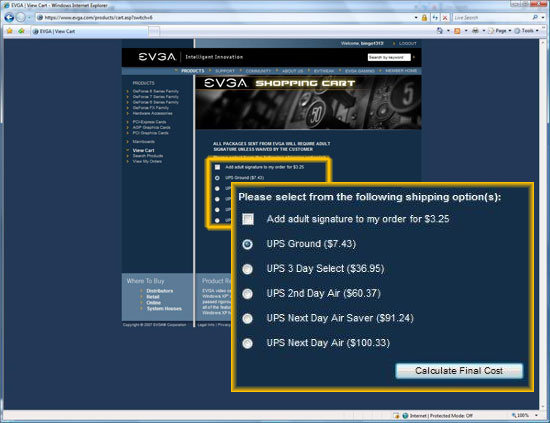
$100.33 for next day air shipping, does it come wrapped in Italian leather?

Don't be fooled by the colors, you'll be paying $380.78 for one of these bad boys
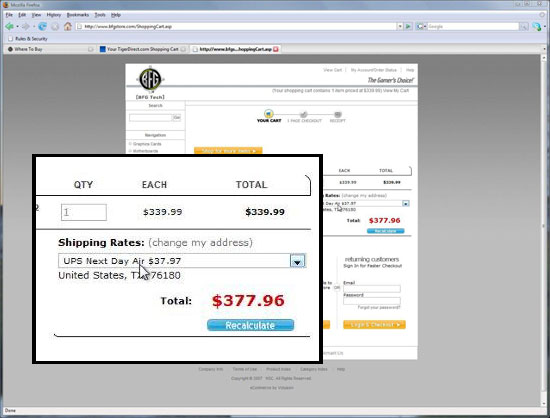
$340 for the card, $40 for shipping, you might as well buy an Xbox 360
If you want one of these things right away it looks like it'll cost you as much as $100 to get it shipped overnight. Who said patience doesn't pay off? Factor in some sort of speedy shipping and you're looking at close to a $400 investment for what was supposed to be a $250 card. With the fruits of capitalism come the inevitable sour grapes, the 8800 GT is a hot item and vendors will do whatever they can to maximize profit on it.
AMD is convinced that this is all a giant conspiracy by NVIDIA to hurt the launch of the Radeon HD 3800 series. Create buzz for a product that on paper destroys the Radeon HD 3870 but don't produce enough to actually make that happen. You have to admit, based on NVIDIA's promises the initial 8800 GT reviews were beyond glowing; but honestly, if we had to write the review today, even knowing the availability problems, the card still gets our recommendation - just at a higher price point.
The fact of the matter is that if you're patient and put in a pre-order with a vendor, you can actually get one of these things at less than $300, just not at $250. AMD should be happy because if the 8800 GT were actually a $250 card, the Radeon HD 3870 would have no place in the market. Instead, we've actually got a very nice set of options:
If you're spending less than $200, the only card to get is the Radeon HD 3850 and if you can find one at $220, the Radeon HD 3870 is good value. And then we've got the 8800 GT, which is effectively a $300 card if you're patient and more like $350 if you want one right away.
But if you're building a HTPC or just want a silent PC and happen to be a gamer, there's one particular flavor of 8800 GT that will interest you the most.
A Silent 8800 GT? Impossible
The night before our 8800 GT review went live, Derek called me and let me know that Sparkle sent along images of a passively cooled 8800 GT. Said one word: "impossible". I told him that it had to be a Photoshop because there was no way you were going to get an 8800 GT running without a fan, the card was simply too hot.
The 754M transistors that make up G92 were simply switching too fast and dissipating too much heat to be cooled by anything without a fan. Sparkle could’ve lowered the clocks, that would’ve made it possible, but I thought there was just no way at stock speeds. And Sparkle was promising a bone stock 8800 GT, sans fan.
I had honestly forgotten about the card until I started work on the 8800 GT roundup, and there it was, in its innocent white box:

I was still skeptical. We've received passively cooled video cards before that wouldn't even work at their stock speeds due to inadequate cooling. We had one 7600 GT in particular back when we were working on the Silent GPU Roundup that wouldn't even work at stock clock speeds in any 3D games, and we went through three samples before everyone determined that the card just couldn't be sold.
But in the back of my mind I was hopeful, after all, the idea of having a 8800 GT without a fan was simply too good. We've already benchmarked the 8800 GT and shown that it is faster than the vast majority of NVIDIA's lineup, easily offering 8800 GTX performance at a lower price. Since a silent 8800 GTX isn't possible, the 65nm G92 GPU on the 8800 GT could just make a few dreams come true.
The Sparkle 8800 GT Passive
This article is called a preview because the 8800 GT Passive just isn't out yet, but Sparkle assures us that it'll be available soon from TigerDirect at $319.
As we've already mentioned, the 8800 GT Passive is bone stock running at a 600MHz core clock, 1.5GHz shader clock and 1.8GHz memory data rate. In other words, this passively cooled best will perform identically to the 8800 GT we reviewed at the end of October. Impressive, if it works.
The front of the card is amazingly simple, there's a black plate where we'd normally see a massive heatsink and a small Sparkle logo, well, sparkles, in the lower right. Sparkle keeps the tough job of cooling away from the front, instead all we've got here is a plate that attaches three heatpipes to the G92 GPU.
The heatsink wraps around the back of the card, keeping it closer to the CPU in your system. The idea is to keep the heatsink in the path of a large case or PSU fan to help keep it cool since the card has no fan of its own. The heatpipes do a great job of moving heat away from the GPU but heatsinks work best if they have some air carrying heat away from the fins.
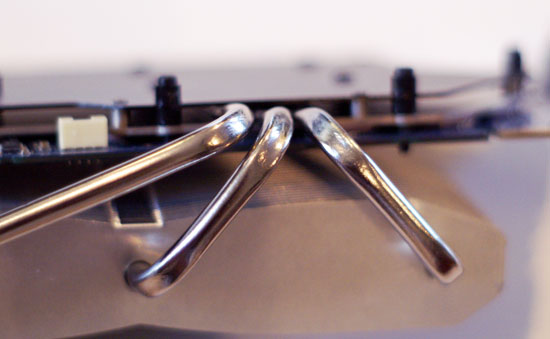
The heatsink design itself is pretty simple; there are a lot of fins made out of a very lightweight aluminum to keep the card's weight down. Despite the larger heatsink the card doesn't seem to weigh any more than a stock 8800 GT. On the flip side you've got to be extra careful with the 8800 GT Passive because these fins are easily damaged, so if you were planning on a sporty game of discus with your 8800 GT don't make it this one.
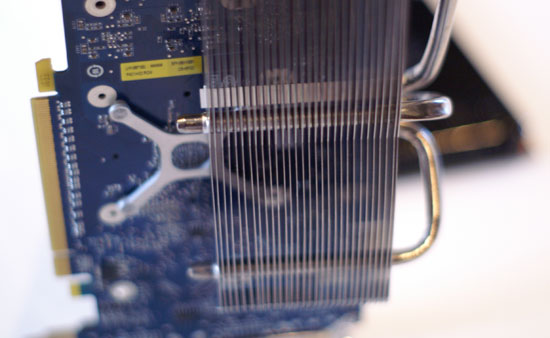
The rest of the card's attributes are standard 8800 GT fare. There's a 6-pin PCIe power connector on one end, two dual-link DVI ports at the other. S-Video out if you want blurry output to a TV, and a single SLI connector if you want to really push the limits and try two passively cooled 8800 GTs in a single system.
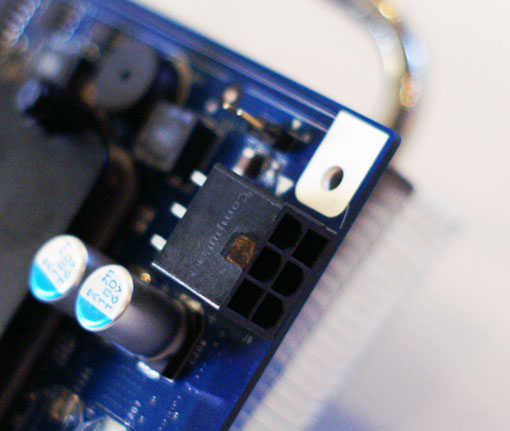
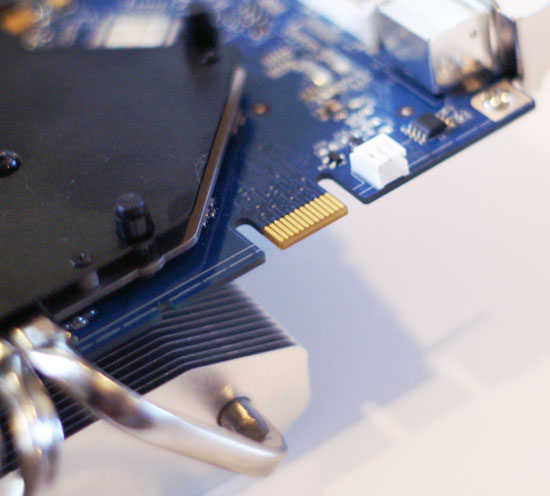
Getting it Going
Remember my skepticism from earlier? I was so eager to find out if this thing worked that I threw it into our Core 2 Extreme QX9770 testbed which was already setup and ready to accept such a thermally defiant graphics card.
Surprisingly enough, it worked. In working on the 8800 GT roundup I quickly discovered that Crysis was an excellent overclocking/thermal test. It turns out that a number of early overclocked 8800 GT boards were either overclocked too far or didn't have their fans set to come on early enough, resulting in a lot of crashing and general unpleasantness. What's most interesting is that these cards would complete our Oblivion and Bioshock tests without a problem, but just firing up Crysis and trying to change resolutions was enough to lock up the entire system. Thus Crysis would be the perfect game to stress test the passively cooled Sparkle.
The G92 GPU temperature maxed out at around 102C (215.6F), which is amazingly hot. The heatsink itself grew hotter than anything we remember ever touching outside of a kitchen. We had to do a sanity check and look up the burning point of paper just to make sure we weren't creating a fire hazard by running this thing.
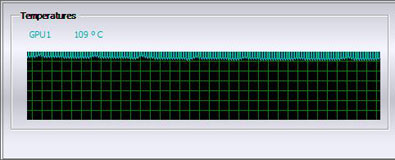
This temp comes from our next test...
Surprisingly enough, the system remained stable and we continued to play Crysis and run through our normal gaming benchmarks without a hitch. However, we had no idea if the 8800 GT Passive would hold up under a more real-world scenario: inside a case.
Making it Hot
We did have an ulterior motive for pairing the Sparkle 8800 GT Passive with our QX9770 test bed, we wanted to toss it in a case with the hottest, fastest Intel processor we had.
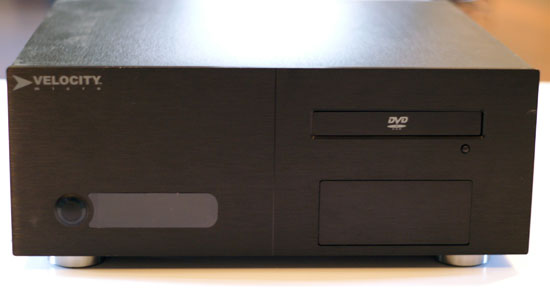
We gutted a nearby Velocity Micro HTPC and swapped in our ASUS P5E3 Deluxe (X38) motherboard and QX9770. If you're not familiar with the QX9770, it's a quad-core 3.2GHz Penryn/Yorkfield based processor that won't be out until early 2008. It's got a TDP of 135W and manages to get quite warm, so putting it three inches away from the Sparkle's fanless heatsink just seemed like a great idea.
We also threw in a 150GB Western Digital Raptor hard drive, we could've gone with something cooler but where's the fun in that?
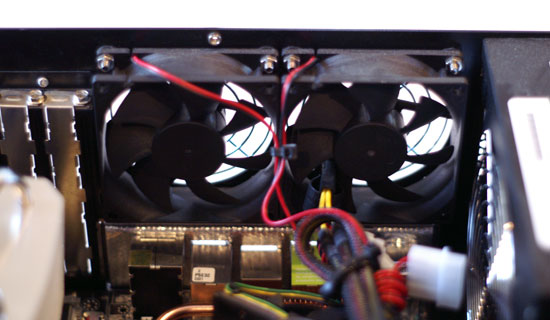
The chassis has two 80mm case fans in the back above the CPU and we tested with them both on and off. The Seasonic SS-700HM PSU has two fans of its own, so running the system without any extra case fans wouldn't be a huge deal.
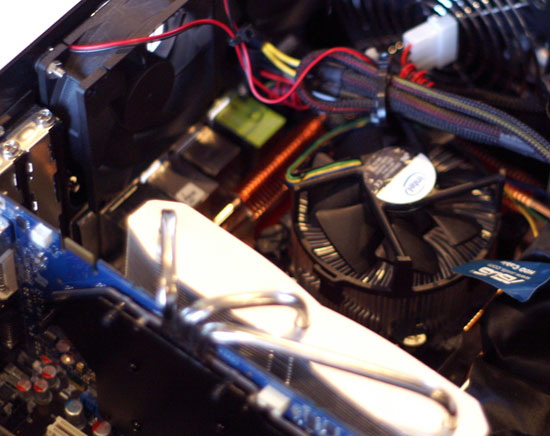
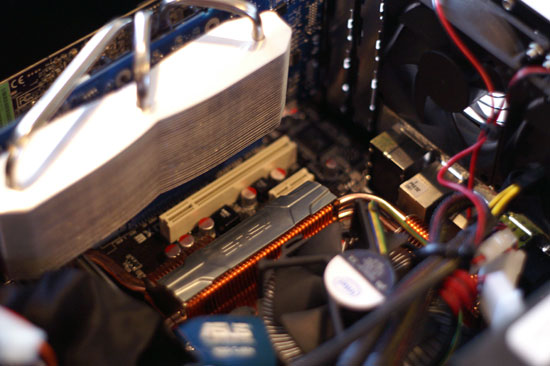
Once again, Crysis was our benchmark of choice as it seems to put the greatest stress on GPUs. We played for hours on end until the GPU temperature leveled off, using nTune to monitor temperature levels from the GPU's on-die thermal diode. Note that playing Crysis actually got these GPUs hotter than looping the 3DMark '06 HDR/SM3 tests, although only by 1 - 2C.
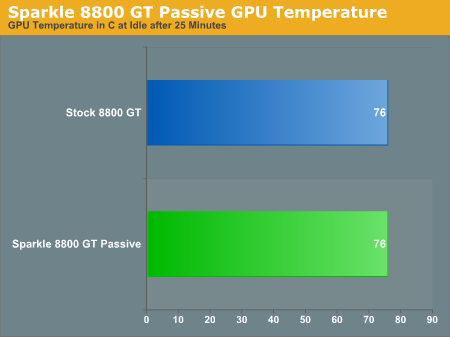
Interestingly enough, at idle, both the stock 8800 GT with its fan and the Sparkle passive card reach about 76C. The only explanation is that the 8800 GT's fan is designed to remain as quiet as possible, so it doesn't actually do all that much cooling when the GPU isn't being stressed.
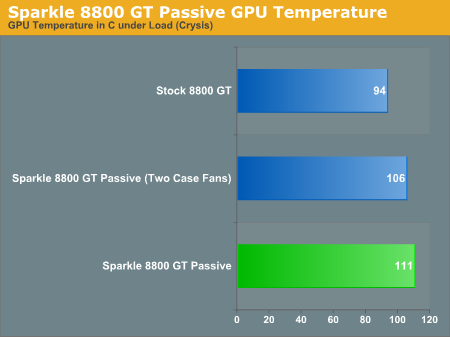
Running Crysis, the stock 8800 GT's GPU peaks at around 94C with the two 80mm case fans in the system unplugged. The passively cooled Sparkle in the same situation is already at 111C, an increase of 17C, not nearly as much as we honestly expected but still quite hot.
Turning the case fans on drops the GPU temperature to 106C, showing that airflow in the chassis is important.
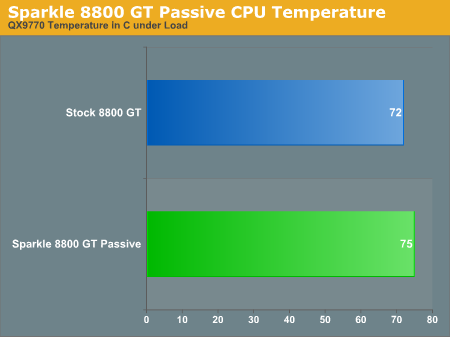
The impact on CPU temperature was actually marginal, the hottest of the four cores of the QX9770 only saw a 3C increase in core temperature.
Despite our best efforts, the Sparkle 8800 GT Passive prevailed, although posting some worryingly high GPU temperatures the card never crashed during our tests.
Final Words
We're impressed. Usually HTPCers have to make a tremendous tradeoff when picking a graphics card, more often than not they're stuck with a pretty fast, but still mid-range GPU. With the 8800 GT, we have a GPU that's basically as fast as an 8800 GTX and with Sparkle's card we have such a beast without a fan.
The card gets hot, but as we've seen, it can easily be used inside a case alongside a very warm CPU. A well ventilated chassis will obviously help and we're not sure what the high temperatures will do to the longevity of the GPU (overclocking the graphics card is obviously not recommended), but that's what warranties are for (it looks like Sparkle provides a one-year warranty on its cards, ouch).
The only thing Sparkle's 8800 GT is missing is HDMI output, but we figure most HTPC users are accustomed to dealing with using DVI only at this point. We do commend Sparkle for making sure that its first 8800 GT would be passively cooled, if more companies would take this approach we might actually see some better product differentiation in the market. Sparkle's website also indicates a 256MB version in the works.
Pricing isn't bad either, although we're skeptical until we actually see these things ship. Given how quickly the other 8800 GTs have sold out, if you see this thing at $319 and are interested, we suggest moving quickly.

